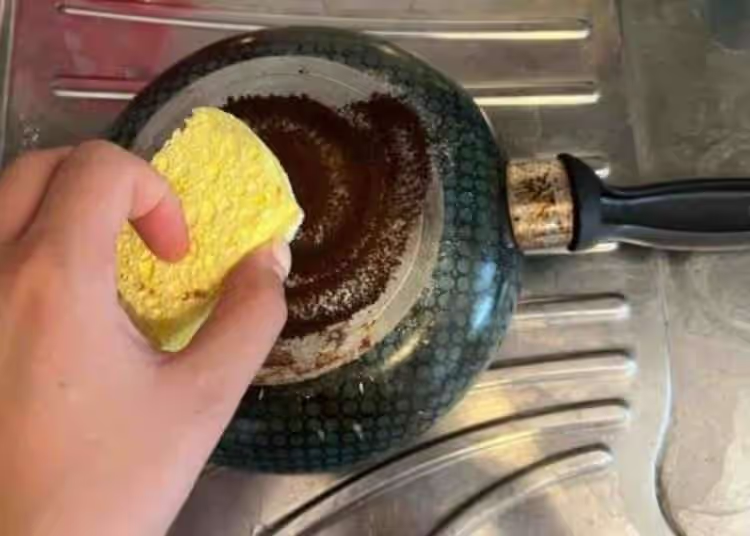Even if there is an old, worn out frying pan in the kitchen, with a few tricks it is possible to restore it to its former glory.
Teflon, its use in the kitchen
Over the past few decades, non-stick frying pans have become extremely popular due to their unparalleled convenience. This category of pans, which typically come with a Teflon interior coating, has actually revolutionized the way we cook at home.
The popularity of nonstick frying pans is due to several factors. Firstly, the Teflon coating allows cooking with less oil or butter, making preparations lighter and healthier.
Thanks to the smooth, non-porous surface, food does not tend to stick, eliminating the annoying problem of food sticking to the pan surface when cooking. This makes cleaning nonstick pans incredibly quick and easy, without the need for intensive scrubbing or scraping.
In addition, non-stick pans have proven to be very versatile. They can be used to cook a variety of foods such as eggs, meat, vegetables and even delicate preparations such as fish. Their ability to distribute heat evenly allows for even cooking and ensures flavorful, well-cooked results.
However, it is important to know the precautions to take when using nonstick pans. If temperatures are too high or scratched by metal utensils, the Teflon coating can be damaged and potentially toxic substances can be released.
To avoid damaging the coating, it is recommended to use silicone or wooden utensils. Additionally, it is important to replace nonstick pans when the coating begins to deteriorate to prevent Teflon particles from getting into the food.
Old frying pans? Be careful how you use them
Non-stick frying pans have certainly simplified our experience in the kitchen and provided us with a practical solution for healthier and cleaner cooking.
With repeated use and washing, non-stick pans can gradually lose their non-stick properties and sometimes even become a potential health hazard. For example, if they are scratched, it is recommended to throw them away and replace them immediately.
While nonstick pans can make cooking and cleaning easier, it’s important to understand that the Teflon coating can deteriorate over time. High temperatures, use of metal utensils and normal wear and tear can cause scratches and peeling of the coating, reducing its effectiveness and encouraging the release of potentially harmful substances.
It is possible to restore nonstick pans, and the process is not as complicated as it seems. There are many methods that can help us return the pan to its original condition.
To restore a nonstick pan, the most common method is to coat the surface layer of the pan with oil.
If a nonstick pan loses its nonstick ability, it can often be restored by applying a layer of oil to the surface. This process returns the pan to its original condition and makes it more resistant to wear and tear.
To restore the frying pan: vegetable oil
To use this method, you can choose different types of oil, such as olive oil or peanut oil. Simply apply a thin layer of oil to the surface of the frying pan, making sure it is completely covered. You can then heat the pan over medium heat for a few minutes to allow the oil to penetrate the non-stick surface. This process creates a new protective layer that restores the non-stick properties of the pan.
It is important to note that you should not use too much oil, otherwise it may create a sticky layer instead of restoring the non-stick properties. Additionally, it is recommended that you remove excess oil from the pan after heating to avoid excessive buildup.
This can be done every six months, but if using a dishwasher it may be necessary to do it every four months.
Old worn frying pan: coconut oil
Place the skillet over the stove flame and heat slightly. In the meantime, preheat the oven to 150 degrees.
Gently apply a little coconut oil to the inner surface of the pan, making sure to spread it evenly. The oil layer should be about 2 centimeters thick. Then put the dish in the oven and let it cook for at least 2 hours.
The heat of the oven allows the oil to completely cover the surface of the pan. After the two hours, turn off the oven and let the pan cool overnight to allow the oil to dry completely.
Through this process, the coconut oil forms a protective layer on the surface of the pan, restoring its non-stick properties. Prolonged exposure to the heat of the oven and then cooling allows the oil to adhere to the pan and form a smooth, non-porous surface.
It’s important to note that this method works best on nonstick pans in good condition, but may be ineffective if the coating is severely damaged. In this case, you may need to consider replacing the pan to ensure safe and efficient cooking.
Old and worn frying pan: baking soda and vinegar
You can use this effective solution as a remedy to clean the frying pan. Start by pouring 250 ml of water, 2 tablespoons of baking soda and 125 ml of white vinegar into the pan. Once the bubbling has stopped, turn on the pressure cooker and let it simmer for 10 minutes.
After the pan has cooled, discard the liquid and dry well. Finally, you can add some vegetable oil to the still hot pan.
